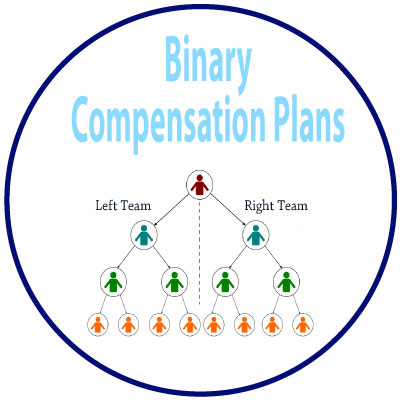 The binary compensation plan is one of the most popular multilevel compensation plans used today by new companies because it does what no other compensation plan type can do, and that is, it pays the upline on an unlimited number of levels of downline volume.
The binary compensation plan is one of the most popular multilevel compensation plans used today by new companies because it does what no other compensation plan type can do, and that is, it pays the upline on an unlimited number of levels of downline volume.
In a binary compensation plan, sales volume is accumulated from each independent representative’s left leg and right leg. Compensation is paid on accumulated unpaid volume in one of three ways:
1/3 – 2/3
A cycle is defined as a total of accumulated unpaid volume from both legs, where at minimum 1/3 of that volume comes from one leg, and a maximum of 2/3 comes from the other leg.
For example, a cycle could be defined as a total of 900 accumulated unpaid volume points. When you have a minimum of 300 points in one leg and a total of 900 points in both legs, you could earn $30 or some other amount.
50 – 50
A cycle is defined as a total of accumulated unpaid volume from both legs, where 1/2 of that volume comes from one leg, and 1/2 is generated from the other leg.
For example, a cycle could be defined as a total of 900 accumulated unpaid volume points. When you have 450 points in one leg and 450 in the other, you could earn $40 or perhaps a different amount.
Percentage of Weaker Leg Volume
With this type of binary, there are no cycles. Independent representatives are paid a percentage of the accumulated unpaid volume in the weaker leg, that is, the leg with the smaller amount of volume.
For example, if you had 200 accumulated unpaid points in your weaker leg, you could earn $20 or perhaps a different amount.
How You Are Paid
With all three flavors of binary, the volume in your weakest leg determines how you will be paid. This means to get paid, you need to increase the volume in your weaker leg.
The best ways to do that are to (a) place your new personally enrolled representatives into your weaker leg and (b) focus your efforts on helping the representatives in your weaker leg to build their businesses.
Which Binary Flavor Is Better?
The answer is there is no clear answer. Which is better depends on two factors and these are:
- Is one of your legs a power leg?
- How much is earned when you are paid?
We will explore each of these factors, but first, let’s explain what a power leg is and who gets one.
What Is A Power Leg?
Because in a binary compensation plan, there are only two spots to fill on an independent representative’s first level, there is spillover. Spillover is the placement of a representative not on one’s first level, but instead on the first level of a downline representative.
A power leg occurs when one of two situations is present:
- Your upline representatives are placing representatives into one of your legs; this is spillover.
- The representatives in one of your legs are building their businesses much faster than the representatives in your other leg.
Are Power Legs Rare Or Common?
Since there are two situations that cause power legs, let’s examine each of them individually.
Power Legs From Your Upline
To become qualified to earn Team Bonuses, it is common to require that an independent representative enrolls one active rep in each of one’s two legs.
The industry average number of representatives enrolled by all representatives is around 2.7. Because the volume in your weakest leg determines how you will be paid, this means on average that 1 rep will be placed into a stronger leg and 1.7 reps will be placed into the weaker leg.
If you are the new rep, this means there is a 1/2.7 chance or about a 37% chance you will be placed into a power leg that was built from the upline’s efforts, but only if your enroller is in a power leg from his upline’s efforts.
If your enroller has a power leg, it is not in your enroller’s best interest to place you into his or her power leg! This fact contributes to the preponderance of representatives who are not placed in a power leg.
Power Legs From Your Enrollment Tree
For the representatives who build an enrollment tree large enough to qualify to be paid binary team bonuses, there will almost always be a power leg because it is very difficult to build your organization in both of your legs exactly evenly all the time. In fact, one’s power leg may switch from one side to the other many times.
Consider This
The 1/3 – 2/3 flavor allows up to 66% of the total volume required to cycle to come from one’s stronger leg. Compared to the 50 – 50 flavor, the 1/3 – 2/3 flavor would increase the company’s total payout, if the amount paid per cycle were equal.
To lower the company’s total payout, the amount paid per cycle is typically less than it would be if the company used a 50 – 50 or percentage of weaker leg approach.
Which Binary Flavor Is More Lucrative For Representatives?
If the amount to be paid for the volume generated in all three flavors were the same, the most lucrative flavor for independent representatives would be the Percentage of Weaker Leg Volume because they don’t need to wait for a specific amount of unpaid accumulated volume to be generated before they are paid.
Comparing 1/3 – 2/3 to 50 – 50
The 1/3 – 2/3 flavor is better for independent representatives who have either type of power leg if the amount paid per cycle was identical between a plan using the 1/3 – 2/3 flavor and a second plan using the 50 – 50 approach.
However, most companies using the 1/3 – 2/3 flavor choose to pay less per cycle than they would if they used the 50 – 50 flavor.
Observation
“What is best for some is not always best for others.”
While the 1/3 – 2/3 flavor may be perceived by some to be easier, for most representatives this isn’t true. When companies pay less per cycle, representatives without power legs suffer more, and there are more representatives without power legs than with them.
If your goal is to be fair to all representatives, the 50 – 50 and the Percentage of Weaker Leg Volume flavors accomplish this goal.
If your goal instead is to reward the smaller percentage of representatives with power legs, the 1/3 – 2/3 flavor may be more to your liking.
To Cycle Or Not To Cycle?
The 1/3 – 2/3 and 50 – 50 flavors use cycles. The Percentage of Weaker Leg Volume flavor does not use cycles as it pays based upon the volume in one’s weaker leg.
About Cycles
Cycles slow down the payout because there are people who won’t be paid now and some who won’t be paid ever when accumulated unpaid volumes don’t reach the thresholds to trigger a binary team bonus. This is good for the direct selling company because it slows the payout down.
In today’s immediate gratification culture, representatives would prefer to be paid on every drop of weaker leg volume so many new binary compensation plans are designed without cycles.
I say the binary compensation plan is like a runaway freight train. We need to slow down the payment of commissions and bonuses. Using cycles is one way to do it, but there are many others.
Sylvina Consulting designs compensation plans. We also professionally evaluate and improve compensation plans designed by others.
To learn more about multilevel compensation plans, watch our compensation plan videos and attend our Direct Selling Edge Conference.

 Jay Leisner, the President of Sylvina Consulting, is a top compensation plan and direct selling expert, a trusted adviser to new and established network marketing and party plan companies. For more than 30 years, Jay has enjoyed assessing and improving network marketing, party plan and referral marketing companies across the globe.
Jay Leisner, the President of Sylvina Consulting, is a top compensation plan and direct selling expert, a trusted adviser to new and established network marketing and party plan companies. For more than 30 years, Jay has enjoyed assessing and improving network marketing, party plan and referral marketing companies across the globe.
Leave a Reply